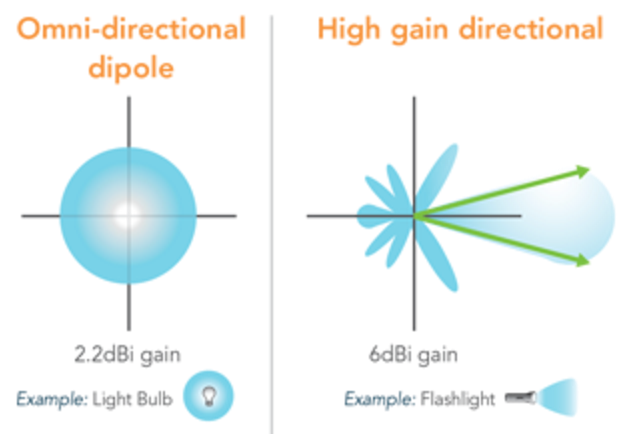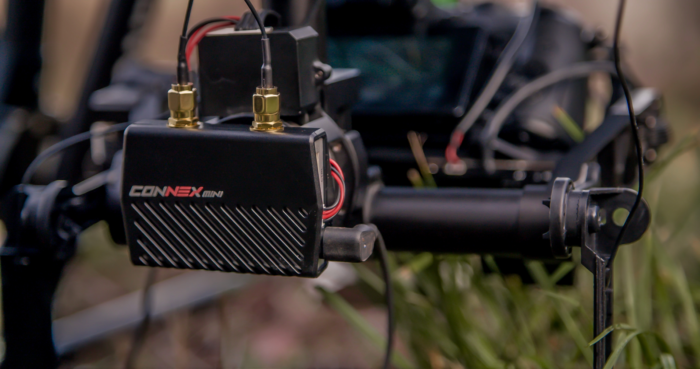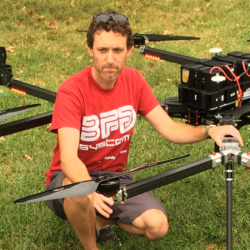As UAS technology has progressed the “weak” points of the system have shifted with time. In the early days it was payload capacity, then flight time, and then camera stability and so on. Every year or so another piece of technology comes out that raises the bar for a particular piece of the system. HD video transmission is relatively new, its only been available for UAS for a couple years. It has become much better over time but in my experience has been one of the major weak points of the whole system, particularly in film and television production. This week BFD Systems with Expressway Cinema Rentals got to preview the next step in HD video transmission. The Connex Patch antenna from Amimon.
A patch antenna is a rectangular shaped antenna, and in the case of video transmission offers a much more focused beam of transmission or reception. They are not new, both Teradek and Paralinx have patch antennas for their HD transmitters. (Which use chips made by Amimon). In the case of the Teradek and Paralinx their patch antennas do not extend the range, but do a great job at blocking out unwanted RF noise from other wireless signals in the area. The Connex Patch is actually a receiver and an antenna in one. We had hands on the prototype which was about 8”x9”. It worked with their existing Connex Mini transmitter. Both the Receiver and transmitter are pretty light weight and are designed for UAS. We had the patch antenna mounted on a C-stand to get it nice and high off the ground and the Connex Mini transmitter velcroed to the side of the camera.

When I found out Shahar from Amimon was going to be visiting for a test my first thought was that we needed to test this thing in a real life situation. It’s one thing to test in a lab or the middle of nowhere but when operating on a film set that is very rarely the case. We wanted to test the new receiver in a high RF environment. At BFD Systems we don’t operate small drones so I figured for high RF test it would be better to car mount the camera and drive through downtown Philadelphia. So for our first test with the help of Expressway Cinema Rentals, we strapped a Movi Pro with a RED Weapon to the roof of my car. We had the receiver at the Philadelphia Art Museum steps and we drove down the parkway to city hall. The first loop we lost signal at about 3,000 feet. “Ah Ha! We’ve stumped the new system!” I thought. We pulled back around to where the ground station was set up. Shahar realized that the antennas on the Movi were still folded down from transit. We flipped them up, and on the next loop around in the car we ran out of parkway before we had any signal degradation. I did not expect that, we needed to find a longer test range.

All transmitters say they are rated for given distance but most often they don’t actually perform to their stated specs. Now it’s important to note that the antennas rely on line of sight. That is to say the receiver and transmitter need to be able to see each other. The 5GHz band that the Connex uses won’t penetrate through buildings or obstructions, at least with their stock antennas. Youtube star and RF wizard IBcrazy has shown some videos where he makes his own antennas that have much greater penetrating power. This 5Ghz band is used by Connex because it’s not as populated as some of the other bands such as 2Ghz and it’s complainant with most countries frequency transmission laws. Line of sight for video transmission is also more like a cone/ donut then a direct line. Say you need to shoot video signal through a narrow space between two buildings, the signal may experience interference from the obstructions on the outer ends of the cone. The other thing is it’s absolutely crucial to make sure positions of the antennas are correct. If using linear polarized antennas (like the ones on the Connex Mini transmitter), out of phase or in an incorrect orientation of the antennas can lose about half of your transmission strength. The difference was night and day when we repositioned the antennas on the Movi by about 90°.
Rent a Drone from Expressway Cinema Rentals
For our next test we took out the drone to get some distance. We wanted to test about 3km, and turns out finding 3km line of sight in Philadelphia is a bit of a challenge. We ended up splitting into two teams. The drone team setup on top of a hill in Fairmount Park. The receiver side drove 3km away to bridge that would be free of trees and obstructions. Google maps said it was 3km but the Connex telemetry was reading 2.6km. We were out of range of the walkie-talkies so with cellphones in hand we had an open line of communication. Although we were not in a high RF environment we were by know means in the middle of nowhere either. We lifted the drone off while the visual observe with the drone team called out our altitude. As soon as we cleared the tree line the signal picked up and image was being received at full strength. It was somewhat bizarre because the drone team could not see the image because it was 3km away, and the receiving team could not see the drone. Over the cell phone the RX team could tell us where to point the camera. At this point we had still had the RED Weapon and were shooting with an 18-35 lens set to 35mm. We spun the camera in all directions to see if there would be interference from the Movi or the drone (which is 1.4 meters wide) but there was nothing but a clear picture. Too clear even, the RX team could have been much farther away to find the limit, but we only has a short amount for time to test before Sharar had to catch his flight home back to Israel.
After this long-range test we just wanted to have some fun, so we decided to meet up with the RX team and rip around our GD-28 drone and chase some cars. For this part we could have used a regular Connex without the patch RX but it was good to test how it would work with higher speeds and more dynamic movements similar to a film set. Even with the directional Patch Antenna facing the complete wrong direction we were getting clear picture at about 300-400 meters.
The Connex line of transmitters is really designed to be used with drones more so than ground-based cameras. It only features an HDMI input, which is painful because we love flying the Alexa Mini which only has SDI output. You can solve this with an HDMI converter. An even cooler solution has been made by a company called Media Black Out. They have released their own version of a rehoused Connex Mini TX that has SDI out and a lemo plug for power. Still you won’t be getting time code or flags sent over the Connex. The Connex series does not have all the features of a Teradek or Paralinx. However for UAS work this is not a deal breaker when you consider the family of Connex transmitters and receivers are a fraction of the weight and a fraction of the cost of other HD transmitters and generally perform much better at the main task of sending wireless HD video. I’m not exactly sure what the new use cases will be for such a long-range video transmutation system. One thing that comes to mind is a feature that allows the Connex to also be used to transmit control signal for the drone. There could be some pretty cool uses cases for long range flights. For now I think the Patch Antenna will be very useful to block out any unwanted RF on a busy film, high traffic areas, or just for really long oners.
Rent a Drone from Expressway Cinema Rentals
Written By: Max Tubman – Owner of BFD Systems

Aerial Expert and Enthusiast. Also an avid knitter of sick quilts and professional javelin tosser. Spends most of his time pondering and finessing his dance moves.